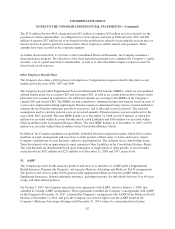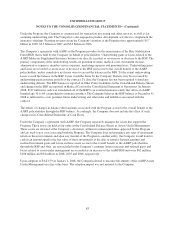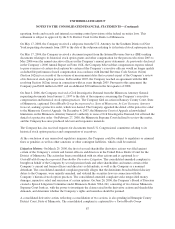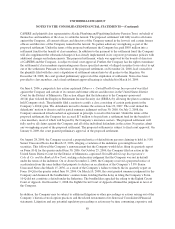United Healthcare 2008 Annual Report Download - page 102
Download and view the complete annual report
Please find page 102 of the 2008 United Healthcare annual report below. You can navigate through the pages in the report by either clicking on the pages listed below, or by using the keyword search tool below to find specific information within the annual report.UNITEDHEALTH GROUP
NOTES TO THE CONSOLIDATED FINANCIAL STATEMENTS—(Continued)
Other examples of audits and investigations include an investigation by the U.S. Department of Labor of the
Company’s administration of its employee benefit plans with respect to ERISA compliance and audits of the
Company’s Medicare health plans to validate the coding practices of and supporting documentation maintained
by its care providers.
Such government actions can result in assessment of damages, civil or criminal fines or penalties, or other
sanctions, including loss of licensure or exclusion from participation in government programs and could have a
material adverse effect on the Company’s financial results. The coding audits may result in retrospective or
prospective adjustments to payments made to health plans pursuant to CMS Medicare contracts.
16. Segment Financial Information
Factors used in determining the Company’s reporting segments include the nature of operating activities,
economic characteristics, existence of separate senior management teams and the type of information presented
to the Company’s chief operating decision-maker to evaluate its results of operations.
The Company’s accounting policies for reporting segment operations are the same as those described in the
Summary of Significant Accounting Policies (see Note 2 of Notes to the Consolidated Financial Statements).
Transactions between reporting segments principally consist of sales of pharmacy benefit products and services
to Health Care Services by Prescription Solutions, certain product offerings sold to Health Care Services
customers by OptumHealth and sales of medical benefits cost, quality and utilization data and predictive
modeling to Health Care Services by Ingenix. These transactions are recorded at management’s estimate of fair
value. Intersegment transactions are eliminated in consolidation. Assets and liabilities that are jointly used are
assigned to each reporting segment using estimates of pro-rata usage. Cash and investments are assigned such
that each reporting segment has at least minimum specified levels of regulatory capital or working capital for
non-regulated businesses.
Substantially all of the Company’s assets are held and operations are conducted in the United States. In
accordance with accounting principles generally accepted in the United States, reporting segments with similar
economic characteristics may be combined. The financial results of UnitedHealthcare, Ovations and
AmeriChoice have been aggregated in the Health Care Services segment column in the following tables because
these businesses have similar economic characteristics and have similar products and services, types of
customers, distribution methods and operational processes, and operate in a similar regulatory environment.
These businesses also share significant common assets, including the Company’s contracted networks of
physicians, health care professionals, hospitals and other facilities, information technology infrastructure and
other resources.
Premium revenues from CMS were 25% of the Company’s total consolidated revenues for the twelve months
ended December 31, 2008, 2007 and 2006, respectively.
92
























